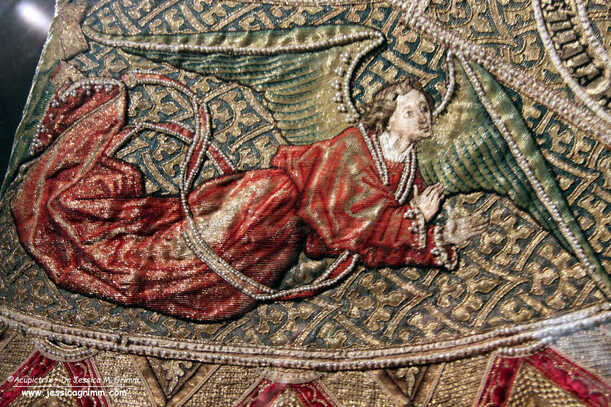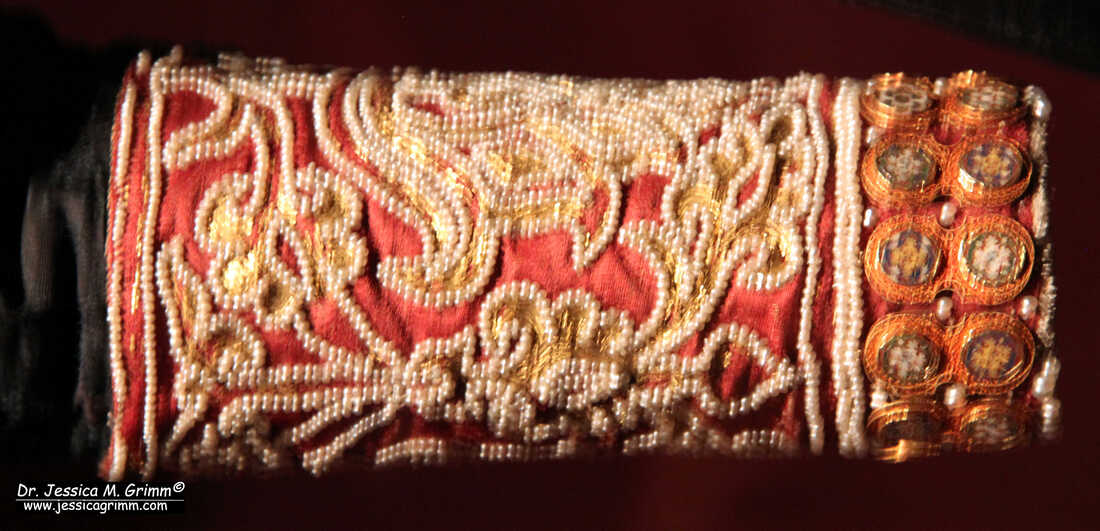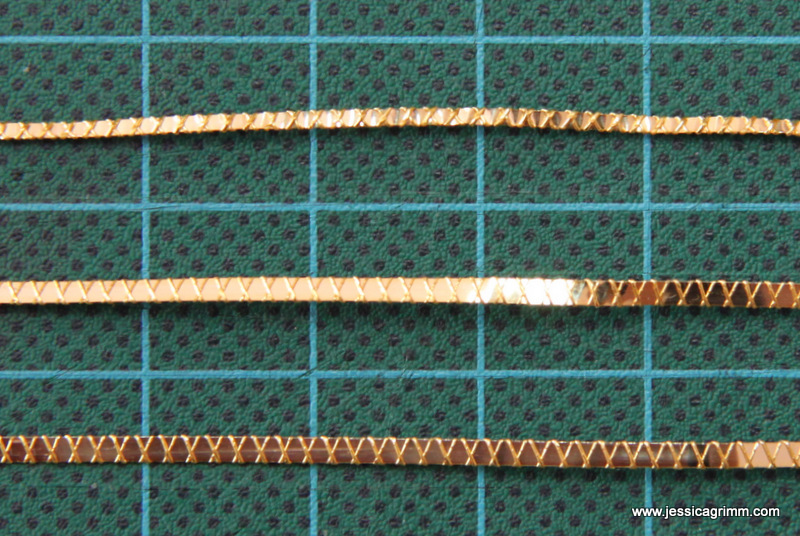|
About two and a half weeks ago, I received an invitation to come to Vienna. The invitation was from M. Maurer, the company that makes my gold threads (here's an earlier blog post about them). They were founded 160 years ago and they were throwing a party for their established customers. My husband and I decided to go as we felt really honoured by the invitation. And visiting Vienna is always a treat. Especially as the city happens to house one of the most important collections of medieval goldwork embroidery in the world: the Vestments of the Order of the Golden Fleece and the Imperial Regalia. But first, let me tell you about the party. It took place in Palais Niederösterreich in the heart of Vienna. The Palais started its life as a late-medieval townhouse of the noble family of Liechtenstein. Vaults in the basement and archaeological finds on display were a clear testament to its older history. Lots of important Austrian events took place in this building throughout its long history. Towards the end of the party, I shot a short video with my phone. The celebration took part in the beautiful baroque hall from 1570. Apart from the party proper, M. Maurer had some additional actions planned for its guests. Firstly, there was a small exhibition with passementerie made by M. Maurer. Think tassels and military decorations. But, to us, the best part of the evening was the impromptu workshops organised by three of its employees. My husband and I opted for the workshop in which we were shown how to make knotted cuff links. These are in essence the same knots you often see on medieval alms pouches. This was so hard! Especially the start. And the lady showing us was VERY patient and sweet. I've always wanted to know how these intricate medieval knots were being made. And I am going to leave you with a picture of a beautiful angel on the chasuble of the Order of the Golden Fleece. It is situated on the front of the chasuble. And whilst it can be accessed in the exhibition you seldom see this side in publications. The or nue on these pieces is absolutely stunning. The gold threads used are so very fine. And the silk embroidery on the faces is mind-blowing. The vestments were made around AD 1430-1440, probably in Brussels, Belgium.
5 Comments
Although my library of books on medieval (goldwork) embroidery is filling more and more IVAR shelves, I still don't have everything :). Hunting publications down is a slow process. There's no central institution or website shouting new releases from the rooftop. Finding older publications often happens by reading through the footnotes and literature lists of publications already on my shelves. Especially chapters in books in which the subject is compared to other existing examples are really helpful. In the book on the Emperor's last clothes I showed you last week, I found some new-to-me information on the embroidery on the Imperial Regalia in Vienna, Austria. I've seen those. They are in a room very close to the spectacular or nué embroideries of the Order of the Golden Fleece. As the embroidered regalia are very old, they are not exactly in the limelight. The room is very dark. So the intriguing goldwork embroidery eludes probably most visitors. Let me introduce you to a very rare goldwork embroidery technique, I had never seen before. From the above picture I took, you can already tell that seeing details of the embroidery on the blue tunic is difficult due to the reduced lighting levels. The tunic was made in the first half of the 12th century in the Royal workshops of Palermo, Sicily. The red bottom seam contains embroidery in underside couching. This is seen in more pieces made in Palermo. The really intriguing embroidery is on the cuffs. From this poor picture I took, you can probably not instantly see what is so special about the goldwork embroidery technique used. If you look real closely, you might see that the embroidery is made of a kind of gold foil tubes sewn down like elongated beads and then flattened. The museum's website states that this is probably the only surviving piece in this technique. The caption in the museum does mention 'gold tubes' in the material list. But when you are not told where to look for them, it isn't easy to spot them in the dimly lit room.
I am most intriguied by this embroidery technique as I feel that these golden tubes were quite fragile and easily deformed. Why did the embroiderer choose this technique and not (underside) couching also in use at the same time in the Imperial workshops? Is the effect achieved so different? Is it quicker to stitch? Or is it easier to make gold tubes compared to gold thread? Any ideas? Yesterday, I gave a brief introduction to the or nue embroidery on the vestments of the Order of the Golden Fleece held in the Imperial Treasury in Vienna, Austria for the 500th show of FiberTalk. My bit runs from 1:08:55 until 1:17:02. When I was preparing my pictures for this short presentation, it suddenly struck me that there were some similarities with a couple of pieces in the collection of the Museum Catharijneconvent in the Netherlands. Not exact matches, but enough similarities to propose that whoever drew the designs for the orphreys from the Catherijneconvent probably knew about the vestments of the Order of the Golden Fleece. Let me show you what I mean. Here you see an orphrey from the Mary cope of the vestments of the Order of the Golden Fleece and on the left an orphrey on cope BMH t622 in Museum Catharijneconvent. Can you see the similarities in the background architecture? The two columns with the arch and the two sharp triangles above look similar on both vestments. Even the colour scheme is the same. The actual blue vault is different in both pieces. In the orphrey on the left, we see a barrel vault and on the right, we see a groin vault. But they are both blue (a popular colour, but not the only one used). Yes, the embroidery on the orphrey from the Order of the Golden Fleece is much more elaborate and of higher skill, but I think the similarities are quite convincing. Interestingly, BHM t622 and ABM t2114 & ABM t2115 are the only orphreys with this type of simple quite bold architecture. But there is more. Something which has always intrigued me regarding ABM t2115 is the fact that the figure of Philip the Apostle is seen on the back. As far as I am aware, there are no other single-figure orphreys where this is the case. However, figures seen on the back are present on the copes of the Order of the Golden Fleece. The figures on the orphreys from Museum Catharijneconvent are worked in a form of long-and-short stitch characteristic of the medieval period. It is more worked like the systematic types of silk shading seen in Chinese embroidery than like the completely random type taught at the Royal School of Needlework. The figures in the vestments of the Order of the Golden Fleece are worked in or nue. However, in this case, both techniques are executed with a lot of skill. You cannot say that the or nue figures are of higher quality than the silk shaded ones (there is a difference in skill when you compare the backgrounds, see above). Again, the colour scheme in these two figures is remarkably similar. However, the drawings of the figures depicted on the vestments of the Order of the Golden Fleece are much more sophisticated. The figures from the Catharijneconvent orphreys are simpler and perhaps not so stylish. This is best illustrated when you compare the figure of Saint Barbara. Barbara on the left is hot, Barbara on the right not so much :). What is also interesting, the silk shading of Barbara on the right is of far lesser skill than that seen for the figure of Philip the Apostle. This indicates that the orphreys from the Catharijneconvent were stitched by embroiderers with different skill sets.
The vestments for the Order of the Golden Fleece were made around AD 1425-1440 in the Southern Netherlands. The orphreys from Museum Catharijneconvent were made c. AD 1490-1500 probably in the Northern Netherlands. Had the person who drew the design drawings for the orphreys from the Catharijneconvent seen a cope of the Order of the Golden Fleece? Perhaps when visiting the Order's chapel in Brussels? Or was this person perhaps even involved in the management of the vestments of the Order of the Golden Fleece? After all, they were already between 50 and 75 years old and must have received regular care to be preserved in such good state until the present day. Both embroiderers and designers needed an education before they could execute their professions. Maybe travelling to see famous vestments was part of their Continued Professional Development? Whatever the case, I think the similarities seen between the pieces in Vienna and those in the Netherlands show that there is a connection of some sort. What do you think? Literature Leeflang, M., Schooten, K. van (Eds.), 2015. Middeleeuwse Borduurkunst uit de Nederlanden. WBOOKS, Zwolle. Schmitz-von Ledebur, K., 2010. Das Messornat des Ordens vom Goldenen Vlies: Sticker im Dienste der burgundischen Herzöge, in: Bergemann, U.-C., Stauffer, A. (Eds.), Reiche Bilder. Aspekte zur Produktion und Funktion von Stickereien im Spätmittelalter. Schnell & Steiner, Regensburg, pp. 25–36. We went to Vienna last week. And although we did a few of the touristy type things, I was especially keen on visiting the passementerie factory of M. Maurer founded in 1863 and suppliers to the Emperor's court (that's Sissi to you and me). Only a few minutes on foot away from the main shopping street Mariahilfer Straße, lies a quiet road called the Kandlgasse. Through a green courtyard you enter a lovely hallway with many period features. Machines are humming while you climb to the first floor shop area. The room is filled with braid trimmings, beads, ribbons, cuffs, tassels and uniform accessories. Nice old-fashioned pattern boards with different styles of machine embroidered lettering, badges and medal ribbons are also on display. However, no gold threads in sight. Luckily, the nice lady fetched some sample boards for me. And then I am a little confused... Not only do they call the different threads different names to what I am used too. After all, that's to be expected given that I usually shop for gold threads in England and this is Austria. No, they even number them differently! Smooth purl #8 thus becomes Boullion glatt/glanz #11 fein. Since I didn't bring a sample, I had to pick my threads by eye. Mental note to self: do make an old fashioned sample card of the threads you have and defend it with your life. Or rather: bring it with you when shopping for gold threads. The very good news is that Maurer still makes some threads and gold thingies not easily available to us embroiderers! And they are even prepared to custom make threads when you provide them with a sample. How cool is that?
|
Want to keep up with my embroidery adventures? Sign up for my weekly Newsletter to get notified of new blogs, courses and workshops!
Liked my blog? Please consider making a donation or becoming a Patron so that I can keep up the good work and my blog ad-free!
Categories
All
Archives
July 2024
|
Contact: info(at)jessicagrimm.com
Copyright Dr Jessica M. Grimm - Mandlweg 3, 82488 Ettal, Deutschland - +49(0)8822 2782219 (Monday, Tuesday, Friday & Saturday 9.00-17.00 CET)
Impressum - Legal Notice - Datenschutzerklärung - Privacy Policy - Webshop ABG - Widerrufsrecht - Disclaimer
Copyright Dr Jessica M. Grimm - Mandlweg 3, 82488 Ettal, Deutschland - +49(0)8822 2782219 (Monday, Tuesday, Friday & Saturday 9.00-17.00 CET)
Impressum - Legal Notice - Datenschutzerklärung - Privacy Policy - Webshop ABG - Widerrufsrecht - Disclaimer






















 RSS Feed
RSS Feed